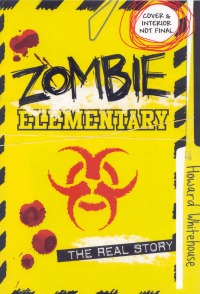| ________________
CM . . .
. Volume XXI Number 2. . . .September 12, 2014
excerpt:
Fifth-grade Larry Mullet tells the story of his school’s zombie infestation to someone named Kyle who interjects occasionally to clarify a point or correct a misused word. Disappointed that most of the adults are completely ignorant of the fact that students and some teachers are turning into zombies, Larry joins forces with his friends Jermaine and Francine, an agent named Mr. O’Hara from BURP (The Bureau of Unresolved Recurring Phenomena), and chainsaw dealers Chainsaw Chucky and his grandmother to trace the origin of the infestation and prevent it from turning the whole school population into zombies. Eventually, they find the cause (tainted meat served in the school cafeteria), lure the zombies into the cafeteria and set it and the meat in question on fire by dousing it with gasoline. BURP shows up and administers an antidote which returns the zombies to their original state. Told in a conversational, completely unpretentious tone that accurately captures the voice of a pre-adolescent boy, this book gets off to a promising and engrossing start. But the story quickly becomes a murky barrage of gratuitous violence, unbelievable adult cluelessness, and awkward references to zombie folklore. For those uninitiated in the powerful (and recently resurgent) myth, very little is provided in terms of background that would provide both explanation and an engrossing parallel narrative. The frequent “zombie tips” inserted in handwritten notes are entertaining and seem to be intended less as explanation than as satire on the zombie myth, itself; and yet, the reader will still yearn to know how this story connects with the myth that so pervades pop culture. That the violence and adult disrespect is so pervasive is not of itself a problem—many children’s literature classics are full of both. It’s that there is no counterpoint. The central problem of the book is solved with large dollops of both, weakened by the sudden appearance of the heretofore ineffectual BURP organization. For a book aimed at middle-graders, it takes some risks that don’t appear to be justified. Larry even wonders “what would Jesus do if he was attacked by zombies?” and responds to Kyle that there’s no way to know as the Roman soldiers that arrested Jesus weren’t going to bite his face off. Even the interjections of conversation between Larry and Kyle, while providing some interesting banter, are difficult to understand, as the role of Kyle (an editor, perhaps?) isn’t made clear. For a book that exploits so fully a contemporary pop culture phenomenon, it doesn’t seem to place itself very well in the second decade of the 21st century. For some reason, Larry doesn’t seem to be able to hide his use of the phone from his parents, who strangely seem to not have a cordless phone. In a nod to contemporary cultural diversity, Larry briefly mentions his Haitian-born classmate Celeste, but then declares that zombies originally came from Haiti where they are the “national monster”. (Still, Celeste’s comparison of the zombies in the story with the Haitian zombie myth does provide the folkloric background otherwise missing in the story.) Larry frequently refers to zombies as “zeds” yet never provides an explanation; some readers may never have heard of this particular slang term. And the character of Chainsaw Chucky is a stereotype of Southern American underclass that is both unnecessary and a jarring fit with the (fictional) quiet, suburban town of Acorn Falls. Zombie Elementary is a book that is bound to connect with some readers, providing the gore and action they are looking for. Yet even the action is difficult to follow—in the final confrontation with the zombies at the school, it is difficult to place where the “zombie hordes” are at any given point in relation to Larry and his friends. And it continues to strain credulity that the official explanation from the always-clueless authority figures for the cafeteria explosion is a “grease fire”. The undead amongst us are a little more obvious than that. Recommended with Reservations. Todd Kyle is the CEO of the Newmarket Public Library in Ontario.
To comment
on this title or this review, send mail to cm@umanitoba.ca.
Copyright © the Manitoba Library Association. Reproduction for personal
use is permitted only if this copyright notice is maintained. Any
other reproduction is prohibited without permission.
Next Review |
Table of Contents for This Issue
- September 12, 2014. |
